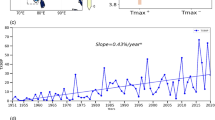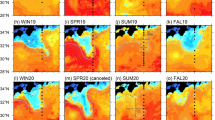Abstract
Using a two-dimensional blocking index, the cause and effect relationship between European blocking (EB) events and North Atlantic Oscillation (NAO) events is investigated. It is shown that the EB event frequency is enhanced over Northern (Southern) Europe for negative (positive) phases of the NAO. Enhanced EB events over Northern Europe precede the establishment of negative phase NAO (NAO−) events, while the enhanced frequency of EB events over Southern Europe lags positive phase NAO (NAO+) events.
The physical explanation for why enhanced EB events over Northern (Southern) Europe lead (lag) NAO− (NAO+) events is also provided. It is found that the lead–lag relationship between EB events in different regions and the phase of NAO events can be explained in terms of the different latitudinal distribution of zonal wind associated with the different phases of NAO events. For NAO+ events, the self-maintained eastward displacement of intensified midlatitude positive height anomalies owing to the intensified zonal wind can enhance the frequency of EB events over Southern Europe, thus supporting a standpoint that EB events over Southern Europe lag NAO+ events. Over Northern Europe, EB events lead NAO− events because NAO- events arise from the self-maintained westward migration of intensified blocking anticyclones due to the weakened zonal wind in higher latitudes.
Similar content being viewed by others
References
Barriopedro, D., R. García-Herrera, A. R. Lupo, and E. Hernández, 2006: A climatology of Northern Hemisphere blocking. J. Climate, 19, 1042–1063, doi: 10.1175/JCLI3678.1.
Barriopedro, D., R. García-Herrera, and R. M. Trigo, 2010: Application of blocking diagnosis methods to General Circulation Models. Part I: A novel detection scheme. Climate Dyn., 35, 1373–1391, doi: 10.1007/s00382-010-0767-5.
Benedict J. J., S. Lee, and S. B. Feldstein, 2004: Synoptic view of the North Atlantic Oscillation. J. Atmos. Sci., 61, 121–144.
Cassou, C., L. Terray, J.W. Hurrell, and C. Deser, 2004: North Atlantic winter climate regimes: Spatial asymmetry, stationarity with time, and oceanic forcing. J. Climate, 17, 1055–1068.
Croci-Maspoli, M., C. Schwierz, and H. C. Davies, 2007: Atmospheric blocking: Space–time links to the NAO and PNA. Climate Dyn., 29, 713–725.
Davini, P., C. Cagnazzo, S. Gualdi, and A. Navarra, 2012a: Bidimensional diagnostics, variability, and trends of Northern Hemisphere blocking. J. Climate, 25, 6496–6509.
Davini, P., C. Cagnazzo, R. Neale, and J. Tribbia, 2012b: Coupling between Greenland blocking and the North Atlantic Oscillation pattern. Geophys. Res. Lett., 39, l14701, doi: 10.1029/2012GL052315.
Diao, Y. N., J. P. Li, and D. H. Luo, 2006: A new blocking index and its application: Blocking action in the Northern Hemisphere. J. Climate, 19, 4819–4839.
Feldstein, S. B., 2003: The dynamics of NAO teleconnection pattern growth and decay. Quart. J. Roy. Meteor. Soc., 129, 901–924.
Franzke, C., S. Lee, and S. B. Feldstein, 2004: Is the North Atlantic Oscillation a breaking wave? J. Atmos. Sci., 61, 145–160.
Glahn, H. R., 1968: Canonical correlation and its relationship to discriminant analysis and multiple regression. J. Atmos. Sci., 25, 23–31.
Hurrell, J. W., 1995: Decadal trends in the North Atlantic Oscillation: Regional temperatures and precipitation. Science, 269, 676–679.
Jung, T., M. Hilmer, E. Ruprecht, S. Kleppek, S. K. Gulev, and O. Zolina, 2003: Characteristics of the recent eastward shift of interannual NAO variability. J. Climate, 16, 3371–3382.
Kalnay, E., and Coauthors, 1996: The NCEP/NCAR 40-Year Reanalysis Project. Bull. Amer. Meteor. Soc., 77, 437–471.
Lejen¨as, H., and H. Økland, 1983: Characteristics of northern hemisphere blocking as determined from a long time series of observational data. Tellus A, 35A, 350–362.
Luo, D. H., 2005: Why is the North Atlantic block more frequent and long-lived during the negative NAO phase? Geophys. Res. Lett., 32, L20804, doi: 10.1029/2005GL022927.
Luo, D. H., and J. Cha, 2012: The North Atlantic Oscillation and the North Atlantic jet variability: Precursors to NAO regimesand transitions. J. Atmos. Sci., 69, 3763–3787.
Luo, D. H., A. R. Lupo, and H. Wan, 2007a: Dynamics of eddydriven low-frequency dipole modes. Part I: A simple model of North Atlantic Oscillations. J. Atmos. Sci., 64, 3–38.
Luo, D. H., T. T. Gong, and Y. N. Diao, 2007b: Dynamics of eddy-driven low-frequency dipole modes. Part III: Meridional displacement of westerly jet anomalies during two phases of NAO. J. Atmos. Sci., 64, 3232–3248.
Luo, D. H., T. T. Gong, and Y. N. Diao, 2008: Dynamics of eddydriven low-frequency dipole modes. Part IV: Planetary and synoptic wave-breaking processes during the NAO life cycle. J. Atmos. Sci., 65, 737–765.
Luo, D. H., Z. H. Zhu, R. C. Ren, L. H. Zhong, and C. Z. Wang, 2010: Spatial pattern and zonal shift of the North Atlantic Oscillation. Part I: A dynamical interpretation. J. Atmos. Sci., 67, 2805–2826.
Luo, D. H., J. Cha, and S. B. Feldstein, 2012a: Weather regime transitions and the interannual variability of the North Atlantic Oscillation. Part I: A likely connection. J. Atmos. Sci., 69, 2329–2346.
Luo, D. H., J. Cha, and S. B. Feldstein, 2012b: Weather regime transitions and the interannual variability of the North Atlantic Oscillation. Part II: Dynamical processes. J. Atmos. Sci., 69, 2347–2363.
Luo, D. H., Y. Yao, and A. G. Dai, 2014: Decadal relationship between European blocking and North Atlantic oscillation during 1978–2011. Part I: Atlantic conditions. J. Atmos. Sci., 72, 1152–1173.
Moore, G. W. K., and I. A. Renfrew, 2012: Cold European winters: Interplay between the NAO and the East Atlantic mode. Atmospheric Science Letters, 13, 1–8.
Pelly, J. L., and B. J. Hoskins, 2003: A new perspective on blocking. J. Atmos. Sci., 60, 743–755.
Rivi`ere, G., and I. Orlanski, 2007: Characteristics of the Atlantic storm-track eddy activity and its relation with the North Atlantic Oscillation. J. Atmos. Sci., 64, 241–266.
Scaife, A. A., C. K. Folland, L. V. Alexander, A. Moberg, and J. R. Knight, 2008: European climate extremes and the North Atlantic oscillation. J. Climate, 21, 72–83, doi: 10.1175/2007JCLI1631.1.
Scherrer, S., M. Croci-Maspoli, C. Schwierz, and C. Appenzeller, 2006: Two-dimensional indices of atmospheric blocking and their statistical relationship with winter climate patterns in the Euro-Atlantic region. Inter. J. Climatol., 26, 233–249.
Schwierz, C., M. Croci-Maspoli, and H. C. Davies, 2004: Perspicacious indicators of atmospheric blocking. Geophys. Res. Lett., 31, L06125, doi: 10.1029/2003GL019341.
Shabbar, A., J. P. Huang, and K. Higuchi, 2001: The relationship between the wintertime North Atlantic Oscillation and blocking episodes in the North Atlantic. International Journal of Climatology, 21, 355–369, doi: 10.1002/joc.612.
Sillmann, J., M. Croci-Maspoli, M. Kallache, and R. W. Katz, 2011: Extreme cold winter temperatures in Europe under the influence of North Atlantic atmospheric blocking. J. Climate, 24, 5899–5913, doi: 10.1175/2011JCLI4075.1.
Sung, M. K., G. H. Lim, J. S. Kug, and S. An, 2011: A linkage between the North Atlantic Oscillation and its downstream development due to the existence of a blocking ridge. J. Geophys. Res., 116, doi: 10.1029/2010JD015006.
Strong, C., and G. Magnusdottir, 2008: Tropospheric Rossby wave breaking and the NAO/NAM. J. Atmos. Sci., 65, 2861–2876.
Tibaldi, S., and F. Molteni, 1990: On the operational predictability of blocking. Tellus A, 42, 343–365.
Woollings, T., B. Hoskins, M. Blackburn, and P. Berrisford, 2008: A new Rossby wave–breaking interpretation of the North Atlantic Oscillation. J. Atmos. Sci., 65, 609–626.
Yao, Y., and D. H. Luo, 2014: Relationship between zonal position of the North Atlantic Oscillation and Euro-Atlantic blocking events and its possible effect on the weather over Europe. Science China Earth Sciences, 57, 2628–2636.
Author information
Authors and Affiliations
Corresponding author
Rights and permissions
About this article
Cite this article
Yao, Y., Luo, D. Do European blocking events precede North Atlantic Oscillation events?. Adv. Atmos. Sci. 32, 1106–1118 (2015). https://doi.org/10.1007/s00376-015-4209-5
Received:
Revised:
Accepted:
Published:
Issue Date:
DOI: https://doi.org/10.1007/s00376-015-4209-5




